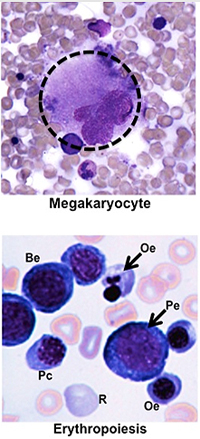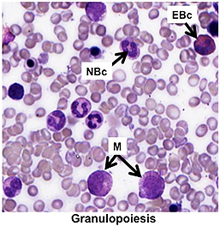|
Examine a smear made from a
bone marrow aspirate. Focus on a
region near the edge of the preparation where the smear is thinner
and cell morphology is relatively well preserved. Note that most of
the cells present are mature red and white blood cells. The empty
circular areas are spaces left by adipocytes that were disrupted
during preparation of the smear. Identifying developing blood cells
can be particularly challenging. However, spend some time looking at
these cells, focusing mainly on identifying cells in the later
stages of development when they begin to acquire features of their
mature forms.  Also, remember that blood cells develop along a
continuum, so their histological features are gradually changing
during each stage. Also, remember that blood cells develop along a
continuum, so their histological features are gradually changing
during each stage.
Identify megakaryocytes, which are distinctive
because of their large size (up to 150 microns in diameter) and very
large, polyploid nuclei. Megakaryocytes produce platelets, which are
released from long cytoplasmic extensions as small, round anucleated
fragments. Look for erythrocyte precursors including:
- Proerythroblasts
(Pe), which are large cells with lacy chromatin and basophilic cytoplasm
- Basophilic erythroblasts (Be), which are slightly smaller
cells with a more condensed nucleus and basophilic cytoplasm
- Polychromatophilic erythroblasts (Pc), which contain
regions of basophilia and eosinophilia as hemoglobin is
produced
- Orthochromatophilic erythroblast (Oe, normoblasts) with
condensing nuclei and increasingly eosinophilic
cytoplasm
- Reticulocytes (R) lack nuclei and their cytoplasm
transitions from lightly basophilic to strongly eosinophilic
 Look for
granulocyte precursors (neutrophil (N), eosinophil (E), and basophil
(B) precursors), which can be identified based on their emerging bilobed or segmented nuclear morphologies and the appearance of
their specific granules: Look for
granulocyte precursors (neutrophil (N), eosinophil (E), and basophil
(B) precursors), which can be identified based on their emerging bilobed or segmented nuclear morphologies and the appearance of
their specific granules:
- Myelocytes (M)
- Metamyelocytes (Mm)
- Band cells
(sometimes referred to as stab cells) (Bc)
Clinical note: Leukemias
are malignancies arising from the hematopoietic precursors of
leukocytes and are classified as lymphocytic leukemia or myelogenous
leukemia, depending on whether lymphocytes or granulocytes are
involved.
Now try this self-assessment
quiz, no one sees the score but you.
Next is
cardiovascular system. |